The technology of led light source is becoming more and more mature, and the luminous lumen per watt is growing rapidly, which makes it reduce the price every year. Taking 1W led light source as an example, the price in spring 2008 is one-third of the price in spring 2006, and will fall to a quarter in 2006 in spring 2009. The massive market of led green lamps and the continuous growth and demand for several years will be the super tsunami of the IC industry after the VCD, DVD, mobile phones and MP3s!
The high performance, long life and environmentally friendly performance of LED lamps are widely recognized.
Led high energy-saving: DC drive, ultra-low power consumption (single tube 0.03 watts - 1 watt) electro-optical power conversion is close to 100%, the same lighting effect is more than 80% energy saving than traditional light sources. Led long life: led light source is called longevity lamp. Solid cold light source, epoxy resin package, there is no loose part in the lamp body, there are no shortcomings such as filament light-emitting, heat deposition, fast light decay and so on.
Led life: the service life can reach 50,000 to 100,000 hours, which is more than 10 times longer than the traditional light source.
Led environmental protection: led is a green light source, environmental protection benefits are better. There is no ultraviolet and infrared rays in the spectrum, low heat and no stroboscopic, no radiation, and waste can be recycled, no pollution, no mercury, cold light source, safe touch, is a typical green lighting source.
Led light source working characteristics The VF voltage of the LED light source for lighting is very low, generally VF = 2.75-3.8V, IF is 15-1400mA; therefore the output voltage of the LED driver IC is VF XN or VF X 1, IF constant current is in 15- 1400mA. The LED light source used in LED lamps has two types of low power (IF=15-20mA) and high power (IF) (200mA)). The low power led is used to make led fluorescent lamps, decorative lamps and grille lamps; high-power LEDs are used for Home lighting, spotlights, underwater lights, wall washers, street lights, tunnel lights, car work lights, etc. The power LED light source is a low-voltage, high-current driving device. The intensity of the light is determined by the current flowing through the LED. If the current is too strong, the LED light will be attenuated. If the current is too weak, the LED will be affected. Therefore, the LED The driver needs to provide a constant current power supply to ensure the safety of high-power LED use and achieve the desired luminous intensity. In the field of led lighting, to reflect the characteristics of energy saving and long life, it is very important to choose a good LED driver IC. There is no good driver IC matching, and the advantages of LED lighting cannot be reflected. Led lighting design needs attention to the technical details of the requirements of led lamps for low-voltage driver chips:
1. The nominal input voltage range of the driver chip should meet DC8-40V to cover the application surface. The withstand voltage should be better than 45V. The simple bridge rectifier output voltage will follow the grid voltage when AC 12V or 24 V input. Fluctuation, especially when the voltage is high, the output DC voltage will be too high. If the driver IC cannot adapt to the wide voltage range, it will be broken down when the grid voltage rises, and the LED light source will be burnt.
2. The nominal output current requirement of the driver chip is greater than 1.2-1.5A. As the LED light source for illumination, the 1W power LED light source has a nominal working current of 350mA, and the 3W power LED light source has a nominal working current of 700mA. Larger ones require more current, so the driver ICs used in LED lighting must have sufficient current output. The design of the product must be such that the driver IC operates at 70-90% of the best working area of ​​the full negative output. Driver ICs that use full negative output currents have poor heat dissipation in the narrow space of the luminaire, which is prone to fatigue and early failure.
3. The output current of the driver chip must be constant for a long time, the LED light source can be stably illuminated, and the brightness will not flicker; the same batch of driver chips are used under the same conditions, and the output current should be as uniform as possible, that is, the dispersion is small, so High-volume automated production line production can be effective and orderly; for the output current has a certain discrete drive chip must be selected before the factory or put into the production line, adjust the resistance of the current setting resistor (Rs) on the PCB, so that The constant current driving board of the LED lamp produced by the same has the same brightness of the same kind of led light source, and maintains the consistency of the final product.
4. The package of the driver chip should facilitate the rapid heat dissipation of the chip die. For example, the die (die) is directly bonded to the copper plate, and a pin extends directly outside the package for direct soldering on the copper foil of the PCB. Rapid thermal conductivity (Figure 1). For example, on a silicon die similar to 4X4mm, it takes a long time to pass 300-1000mA current, which inevitably has power consumption, which will inevitably heat up. The physical heat dissipation structure of the chip itself is also crucial.
5. The ability of the driver chip itself to resist EMI, noise and high voltage is also related to whether the entire LED lighting products can pass CE, UL and other certifications. Therefore, the driver chip itself must use excellent topological structure and high voltage at the beginning of design. Production Process.
6. The power consumption requirement of the driver chip is less than 0.5W, and the switching operating frequency requirement is greater than 120Hz, so as to avoid visible flicker caused by power frequency interference. Led green lighting promotes the development of driving chips to innovative designs. LED lighting is inseparable from driving chips, so LED light source driving ICs with multiple functions are required. Led lamps use AC power below 36V to consider non-isolated power supply. For example, 220V and 100V AC power should be considered for isolated power supply. Directly using the AC100-220V driver chip, due to the application of the demanding requirements, there are higher technical requirements and greater difficulty, and countries are currently working hard to develop. The massive demand market for led luminaires gives all IC design companies the chance to succeed again, with rapid transformation and early product launch, and many opportunities to win.
High Frequency PCB - Definition, Characteristics, Manufacturing, Materials and Application Scenarios
With the development of science and economy, the electronic industry has become an important driving force for economic development. Electronic products have become a part of life, affecting people's way of life. High-frequency circuit boards are widely used in many electronic industries and some instruments and equipment, and high-frequency PCB applications are also increasing. Choose high-frequency circuit board manufacturers in good service to buy high-quality products for use, we have to understand the relevant knowledge of high-frequency board.
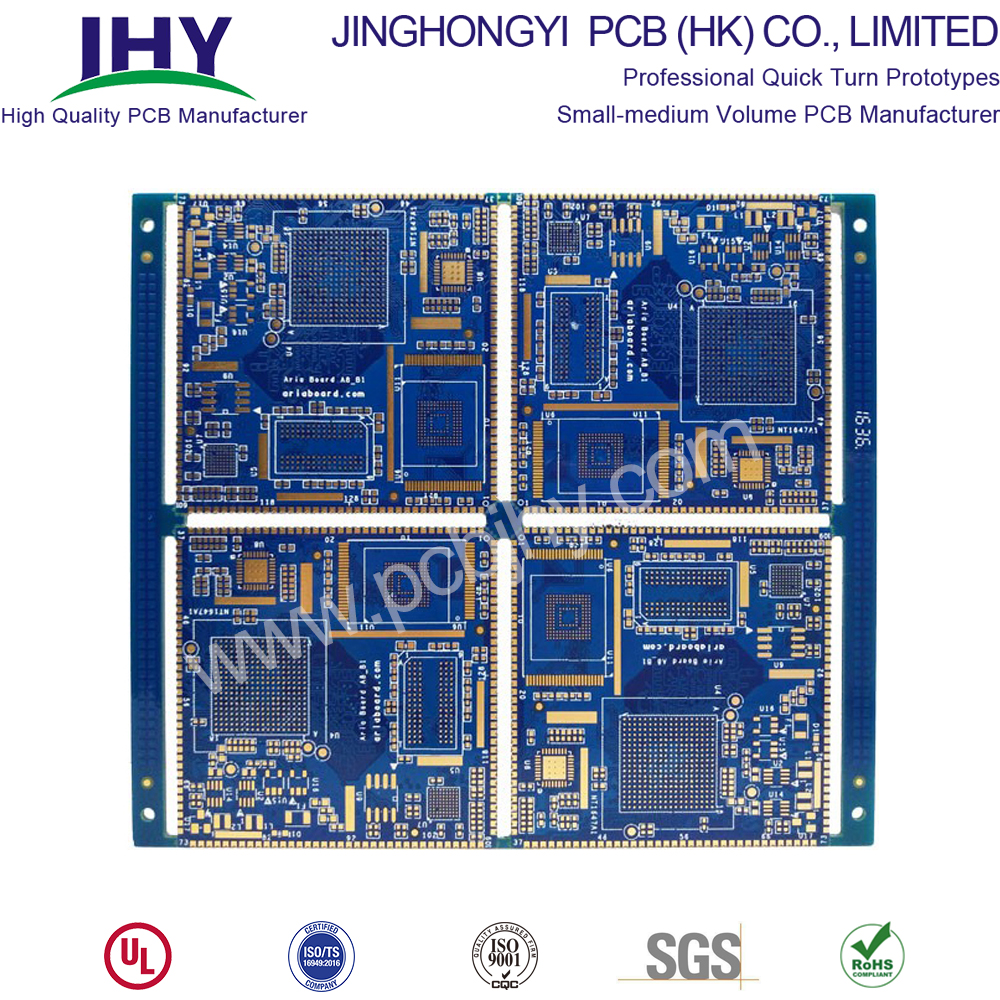
What Is A High Frequency Circuit Board?
High frequency circuit board (HF PCB) is a special circuit board with high electromagnetic frequency. Generally speaking, high frequencies can be defined as frequencies above 1GHz. Its physical performance, accuracy and technical parameters are very demanding. It is often used in automobile anti-collision system, satellite system, radio system and other fields.
High Frequency PCB include:
- Rogers high frequency PCB
- Power amplifier high frequency PCB
- Buried blind hole mixed high frequency PCB
- Ceramic high frequency PCB
- Ceramic mixed high frequency PCB
- Communication antenna high frequency PCB
- GPS antenna high frequency PCB
- FR-4 high frequency PCB
- Double sided high frequency PCB
- Microwave High Frequency PCB
- Induction High Frequency PCB
- 2.4G Radar Induction PCB
- 5.8G Microwave Induction PCB

The utility model patented high frequency circuit board includes a core board with a hollow groove and a copper clad plate adhering to the surface and the lower surface of the core board by flow glue. The upper opening and the lower opening edges of the hollow groove are provided with a baffle.
The high frequency circuit board provided by the utility model is provided with a barrier which can block the flow glue at the upper and lower edges of the hollow groove of the core board.
In this way, the flow glue will not enter the hollow slot when the core plate is bonded with the copper clad laminate placed on the upper and lower surfaces, that is, the bonding operation can be completed by one press.
Compared with the existing technology, the high frequency circuit board can only be completed by secondary pressing. The high frequency circuit board in the utility model has the advantages of simple structure, low cost and easy manufacture.
Characteristics of High Frequency Circuit Board
Generally speaking, high frequency circuit boards have their own characteristics: low dielectric constant, relatively stable. In theory, the smaller the dielectric constant, the more stable the signal, and the higher the frequency circuit board can play a better role in signal transmission. Medium loss is very small, it is not easy to absorb water and moisture, heat resistance, corrosion resistance and other excellent performance. Conversely, if the dielectric constant is high, the signal transmission process is slow.
The thermal expansion coefficients of high frequency circuit boards and copper foil are also correlated to a certain extent. They are consistent as far as possible. The inconsistency can easily lead to the separation of copper foil in the alternate change of heat and cold. The later use will affect the signal transmission of PCB. The absorbency of high frequency circuit board is lower than that of other multi-layer circuit boards, because humidity will affect the dielectric constant and dielectric loss of high frequency circuit board. In addition, the heat resistance, chemical resistance, impact strength, peeling strength and other requirements are also good.
High frequency signals are vulnerable to noise and come with much tighter impedance tolerance as compared to conventional circuit boards.
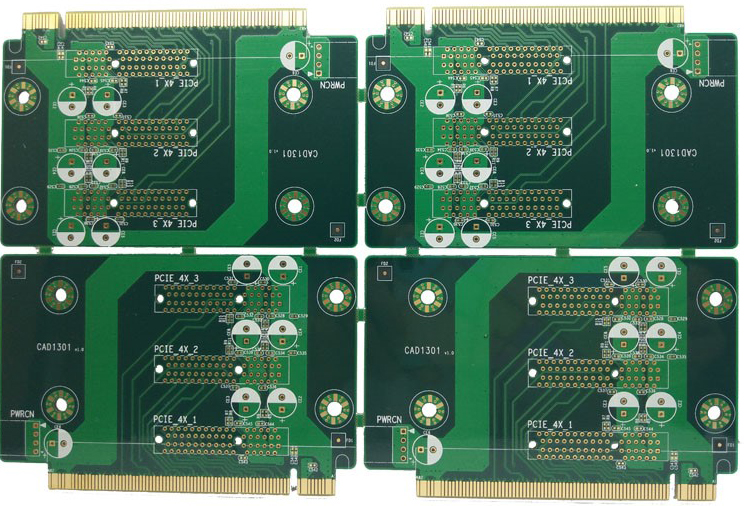
High Frequency Circuit Board Materials
High frequency PCB have their own unique plates. Special materials are used to attain the high frequency given by the High Frequency PCB. PCB manufacturer commonly used Materials are: rogers(Rogers 4350B HF.Rogers RO3001.Rogers RO3003).Taconic(RF-35 Ceramic.TLX). Arlon(85N).Isola(IS620 E-fibre glass).F4B.TP-2.FR-4,Dielectric constant 2.2-10.6 and so on. FR4 is the cheapest one, while Teflon is the most expensive one. But they all have a common characteristic, which is the resin used in the material. The wiring of high frequency circuit board is exquisite and has great influence on components. High-frequency signals have the strongest impact on analog devices, so we should deal with the relationship between them to achieve the best performance. Therefore, high frequency is not easy to pass through high capacity electrolytic capacitors with poor high frequency performance.
The substrate material used in the high-frequency circuit board needs to have excellent electrical properties, good chemical stability, and the loss on the substrate is very small as the frequency of the power signal increases, so the importance of the high-frequency board is highlighted.
Therefore, when selecting a substrate for a PCB for a high-frequency circuit, it is particularly necessary to examine the various characteristics of the material DK at different frequencies. For the requirements of high-speed transmission of signal emphasis, or characteristic impedance control requirements, focus on DF and its performance under conditions of frequency, temperature and humidity.
Under the condition of frequency change, the general type of substrate material shows a large change of DK and DF values. Especially in the frequency range of l MHz to l GHz, their DK and DF values change more significantly. For example, a general-type epoxy resin-glass fiber-based substrate material (general type FR-4) has a DK value of 4.7 at a frequency of 1 MHz, and a DK value of 4.19 at a frequency of 1 GHz. Above lGHz, its DK value tends to be flat. The changing trend is smaller as the frequency increases (but the change is not large). For example, at 10 GHz, the DK value of FR-4 is generally 4.15, and the substrate material having high-speed and high-frequency characteristics changes in frequency. In the case of DK, the DK value changes little, and the DK keeps changing in the range of 0.02 from the frequency of change from 1 MHz to 1 GHz. Its DK value tends to decrease slightly from low to high frequency.
The dielectric loss factor (DF) of a general type of substrate material is affected by a change in frequency (especially in a high-frequency range), and the change in DF value is larger than that of DK. The law of change tends to increase. Therefore, when evaluating the high-frequency characteristics of substrate material, the focus of its investigation is on the change of its DF value. There are two distinct types of two types of substrate materials with high-speed and high-frequency characteristics. In general, there are two different types of substrate materials: one is that the (DF) value changes little with frequency. There is also a class that, although similar in magnitude to the general substrate material, has a lower (DF) value.
High-frequency circuit boards with induction heating technology have been widely used in the communication industry, network technology field promotion and high-speed information processing systems to meet the requirements of many high-precision parameter instruments. A reliable high-frequency circuit board provides great help in actual production.
From material DF:
The circuit board material with DF between 0.01 and 0.005 is suitable for the digital circuit with the upper limit of 10Gb / S;
DF between 0.005-0.003 is suitable for digital circuits with an upper limit of 25gb / s;
Circuit board materials with DF no more than 0.0015 are suitable for 50GB / s or even higher speed digital circuits.
Common high-speed PCB materials are:
1) Rogers: ro4003, ro3003, ro4350, ro5880, etc
2) TUC: tuc862, 872slk, 883, 933, etc
3) Panasonic:Megtron4.Megtron6, etc
4) Isola: fr408hr, is620, is680, etc
5) Nelco:N4000-13.N4000-13EPSI, etc
6) ShengYi
Of course, there are many other high-frequency board materials, such as Arlon (acquired by Rogers) and Taconic, which are all old brand RF microwave material factories with guaranteed performance.
Our most common request is for FR-4 material, which is composed of woven fiberglass bound by an epoxy resin, and which we always keep stocked as one of our PCB Options at a Standard Price. FR-4 is a robust material with excellent thermal characteristics, and electrically it is known to perform quite reasonably at RF or Microwave frequency levels.
Some clients whose designs are intended for particularly demanding applications-such as high-power or broadband circuits-find that FR-4 sometimes just does not do the job at those higher frequencies. In these cases, we are always happy to help you find a laminate material to suit your specific needs, and our highly customizable PCB Assembly Process can be easily adjusted to make sure your project lead time is not impacted.
A snapshot of the datasheet for FR-4 material is shown below for reference.
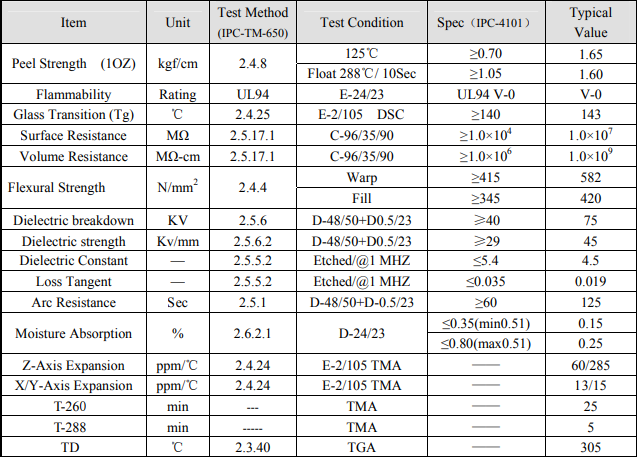
The most popular high-frequency-specific laminate materials were developed by Rogers, and referred to with an [RO-[ prefix. These high-quality materials exhibit approximately a 20% reduction in dielectric constant, compared to standard FR-4; they also boast rather impressive thermal characteristics, with Tg values above 280°C . A snapshot of the datasheet for RO4350B and RO4003C is included below for your convenience.
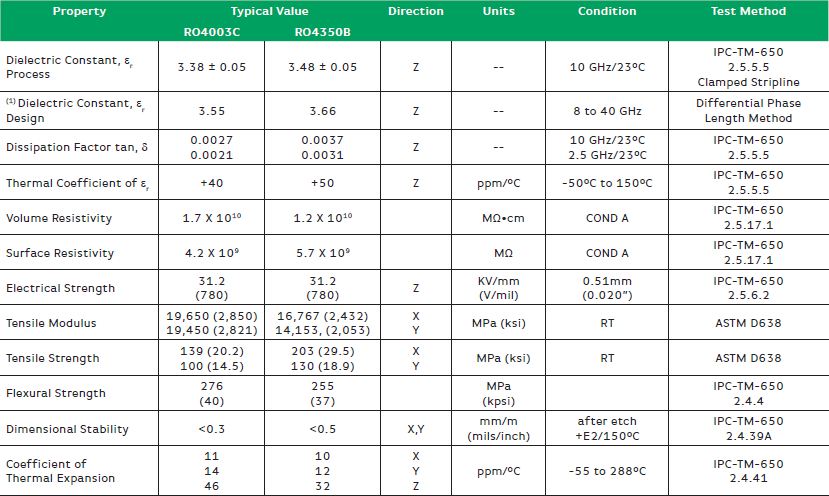
Requirements for Manufacturing Materials of High Frequency PCB
1. Dielectric loss (Df) must be small, which mainly affects the quality of signal transmission. The smaller the dielectric loss, the smaller the signal loss.
2. Low water absorption. High water absorption will affect dielectric constant and dielectric loss when damped.
3. The dielectric constant (DK) must be small and stable. Usually the smaller the better. The transmission rate of the signal is inversely proportional to the square root of the dielectric constant of the material. High dielectric constant easily causes signal transmission delay.
4. The coefficient of thermal expansion of copper foil is the same as that of copper foil, because the inconsistency will cause the separation of copper foil in the change of cold and heat.
5. Other heat resistance, chemical resistance, impact strength and peeling strength must also be good.
Generally speaking, high frequency can be defined as frequency above 1 GHz. At present, most of the high frequencies used are fluorine dielectric substrates. Teflon is much better than other substrates, such as PTFE, which is usually called Teflon. However, Teflon substrate has the disadvantage of high cost and large heat resisting property..
How to choose high frequency high speed PCB material
To select the PCB substrate, a balance must be made among meeting the design requirements, mass production and cost. In short, the design requirements include electrical and structural reliability. Generally, when designing a very high-speed PCB Board (frequency greater than GHz), PCB material problem will be more important. For example, the FR-4 material, which is commonly used now, has a large dielectric loss DF (dielectric loss) at several GHz, which may not be applicable.
For example, 10Gb / s high-speed digital signal is a square wave, which can be regarded as the superposition of sine wave signals of different frequencies. Therefore, 10Gb / s contains many different frequency signals: 5GHz fundamental signal, 3-order 15GHz, 5-order 25ghz, 7-order 35GHz signal, etc. The integrity of the digital signal and the steepness of the upper and lower edge are the same as the low loss and low distortion transmission of the RF microwave (the high-frequency harmonic part of the digital signal reaches the microwave frequency band). Therefore, in many aspects, the selection of high-speed digital circuit materials is similar to the requirements of RF microwave circuits.
The main factors to be considered in the selection of suitable base materials are as follows:
1. Manufacturability:
2. Various performances (electrical, performance stability, etc.) matching with products:
Low loss, stable Dk/Df parameters, low dispersion, small variation coefficient with frequency and environment, small tolerance of material thickness and glue content (good impedance control), if the trace is long, consider low roughness copper foil. In addition, the high-speed circuit needs to be simulated in the early stage of design, and the simulation result is the reference standard of the design. "Xingsen Technology-Agilent (High Speed/RF) Joint Lab" solves the performance problems of inconsistent simulation results and tests. It has done a lot of simulation and actual test closed-loop verification, and the simulation can be consistent with the actual measurement through unique methods.
3. The availability of materials in a timely manner:
Many high-frequency board material procurement cycles are very long, even 2-3 months; in addition to the conventional high-frequency board material RO4350 in stock, many high-frequency boards material need to be provided by customers. Therefore, high-frequency plates need to communicate with manufacturers in advance, and prepare materials as soon as possible;
4. Cost:
5. Applicability of laws and regulations:
It should be integrated with environmental protection regulations of different countries to meet the requirements of RoHS and halogen-free.
Among the above factors, the high-speed digital circuit operation speed is the main factor to be considered in PCB material selection. The higher the speed of the circuit, the smaller the DF value of the selected PCB material. The low loss circuit board will be suitable for 10Gb / s digital circuit; 25gb / s digital circuit needs to select the board with lower loss; ultra-low loss board will be suitable for the faster high-speed digital circuits, and its speed can be 50GB / s or higher.
How to Make High Frequency Circuit Board?
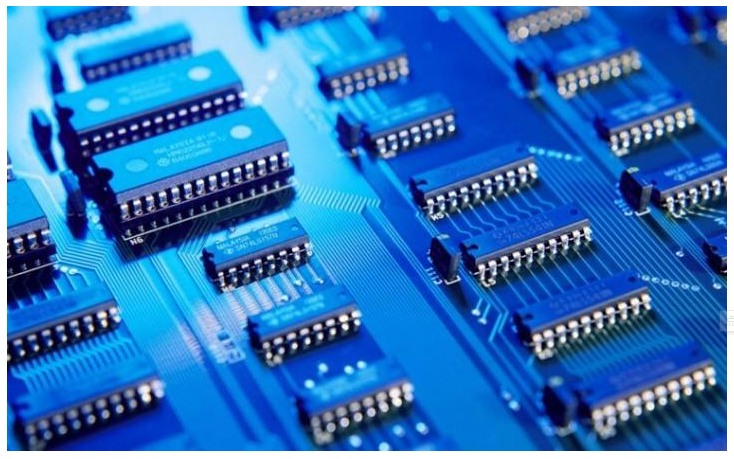
Fabrication Principle of High Frequency Circuit Board
In the design of high frequency circuit, the power supply is designed in the form of layers, which is much better than that in the form of buses in most cases, so that the circuit can always follow the path with the smallest impedance. In addition, the power board has to provide a signal loop for all generated and received signals on PCB, which can minimize the signal loop and reduce noise, which is often ignored by low frequency circuit designers.
In the design of high frequency PCB, we should follow the following principles:
- Unity of power supply and ground, stability.
- Careful wiring and proper termination can eliminate reflection.
- Careful consideration of wiring and proper termination can reduce capacitive and inductive crosstalk.
- Noise suppression is needed to meet EMC requirements.
Points for Attention in Manufacturing High Frequency Circuit Board
1. Impedance control is strict, relative line width control is very strict, general tolerance is about 2%.
2. Because of the special plate, the adhesion of PTH copper deposit is not high. Usually, plasma treatment equipment is needed to roughen the through-hole and surface to increase the adhesion of PTH copper and solder resist ink.
3. Do not grind the plate before welding resistance, otherwise the adhesion will be very poor, and can only be coarsened with micro-corrosive powder.
4. Most of the sheets are PTFE materials. There will be many rough edges when they are formed by ordinary milling cutters, which need special milling cutters.
5. High frequency circuit board is a special circuit board with high electromagnetic frequency. Generally speaking, high frequency can be defined as frequency above 1 GHz.
Its physical performance, accuracy and technical parameters are very demanding. It is often used in automobile anti-collision system, satellite system, radio system and other fields.
Scenario and Field of High Frequency Circuit Board Application:
- Communication Base Station
- Repeater
- GPS antenna
- Radio Frequency Antenna
- power amplifier
- Signal amplifier
- Wave filter
- coupler
- attenuator
- Power divider
- 3DB Bridge, etc.
Nowadays, the high frequency of electronic equipment has become a trend of development, especially in the growing development of communication networks, aerospace, military equipment, intelligent transportation, information products are also increasingly high-speed and high-frequency. Nowadays, with the development of science and economy, many new products need high frequency circuit boards. High frequency circuit boards play an increasingly important role in people's daily life.
It is not easy to find a fast and good manufacturer of high frequency circuit boards. Jinghongyi PCB has its own unique board advantages in making high frequency circuit boards. It has reliable automatic production equipment and testing equipment.
Reasons for Choosing Jinghongyi PCB
1. Top imported raw materials for high frequency circuit boards to ensure product quality from the source
- Plate: Shengyi, South Asia, KB.Rogers.Taconic. Isola. Arlon.F4BM.Nelco.Hitachi.
- Potions: Rohm&Haas (US) Atotech (Germany) Umicore (Germany)
- Ink: Taiyo (Japan)
- Dry membrane: Asahi (Japan), Dupont (US)
2. Full set of surface treatment equipment to meet the needs of various industries
We are one of the few companies in PCB industry equipped with complete surface treatment equipment.We can deal with the Immersion Gold completely.
Immersion Silver, Immersion tin, OSP, tin spraying, gold plating, thick gold plating, tin plating, silver plating and other related requirements.
3. Leading PCB Multilayer Circuit Board Technology Capability
- Maximum Layer: 28 layer
- Maximum Plate Thickness: 6.0mm
- Maximum Thickness to Diameter Ratio 10:1
- Maximum Copper Thickness: 6OZ
- Maximum working plate size: 1000x610mm
- Thinnest 4 Layer PCB : 0.33mm
- Minimum mechanical hole/pad: 0.2/0.40mm
- Drilling accuracy: +/-0.05mm
- PTH Aperture Tolerance: +/-0.05mm
- Minimum Linewidth/Line Spacing: 3mil/0.075mm
4. Strict PCB quality control system to effectively guarantee product performance
- Strictly control according to IPC standard to ensure 100% qualified rate of shipment quality.
- Implement quality PDCA cycle process to continuously improve product performance
- Imported DIONEXICS-900 and Temperature Cycle Inspection Equipment from USA to ensure high reliability and stability of products
5. Top Technical Team
Eight years of focus on R&D and manufacture of high-frequency board and microwave radar RF circuit board, with a dedicated, united and tenacious R&D team, customers NPI stage products, all into the process evaluation system, meet the evaluation criteria of the project, further review by the R&D team and file a case tracking the whole process.
The staff has 3-12 years of professional and technical personnel with multi-layer circuit board experience. They have rich experience in various industry standards and process quality requirements.
6. Intimate service
Service concept: regard customers as eternal partners, develop together, only choose reputation, not customers, regardless of the size of customers, in the case of customer needs, to provide the best service.
Flexible service: We will be eager to meet the customers'needs, think what they want, and do our best to help customers solve problems, reduce losses or promote project development.
Useful Resources
- Ten PCB Routing Rules for High Frequency Circuits
- Difference between High Frequency Circuit and High Speed Circuit
- Interference Analysis and Countermeasure in High-Frequency PCB Design
High Frequency PCB
High Frequency PCB, High Frequency Circuit Board, High Frequency PCB Design, High Frequency PCB Materials
JingHongYi PCB (HK) Co., Limited , https://www.pcbjhy.com